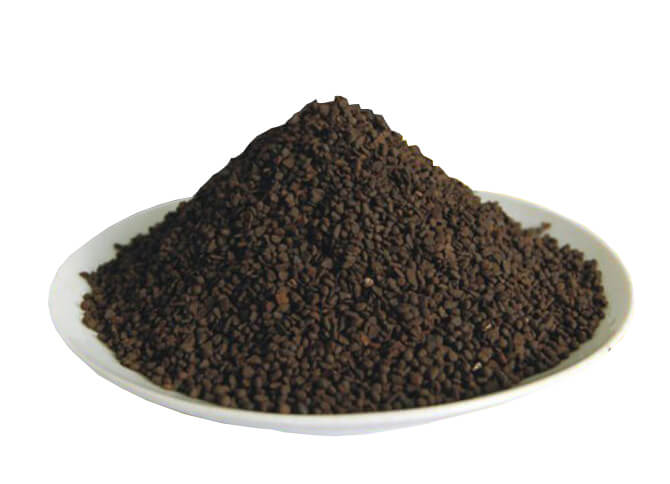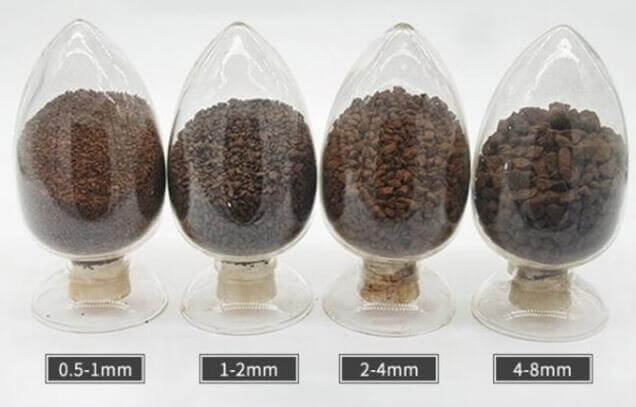Manganese sand, or manganese greensand, is a natural filter media used in water treatment and purification processes. It is called “greensand” because of its greenish-black color, which results from manganese oxide coatings on the surface of the sand particles.

Manganese sand is primarily used to remove impurities from water sources, including:
- Iron
Manganese sand effectively removes ferrous (dissolved) and ferric (particulate) iron from water. It works by oxidizing the ferrous iron to a solid form that can be filtered out. - Manganese
Manganese can be problematic in water supplies, and manganese sand can be removed through adsorption and oxidation processes. - Hydrogen Sulfide
Manganese sand can also remove hydrogen sulfide, which can cause foul odors and taste issues in drinking water.
Manganese Sand Features
- High Adsorption Capacity
Manganese sand has a high adsorption capacity for various impurities, particularly iron, manganese, and hydrogen sulfide. It effectively captures these contaminants from water as it passes through the filter bed. - Oxidation Properties
Manganese sand has natural oxidizing properties. It can convert soluble ferrous iron (Fe2+) to insoluble ferric iron (Fe3+), which can then be filtered out. This oxidation process contributes to its effectiveness in removing iron and manganese from water. - Affordability
Manganese sand is relatively cost-effective compared to other water treatment media, making it an attractive option for smaller water treatment facilities or applications with budget constraints. - Natural and Sustainable
Manganese sand is a natural filter media derived from geological deposits. It is considered a sustainable and eco-friendly choice for water treatment, as it doesn’t involve synthetic chemicals. - Versatility
Besides its primary function of removing iron, manganese, and hydrogen sulfide, manganese sand can also help reduce levels of other impurities like arsenic, radium, and some heavy metals in water. - Easy Regeneration
Manganese sand can be regenerated or reactivated relatively easily. Periodic backwashing and regeneration processes can help restore its adsorption capacity and extend its lifespan, making it a cost-effective choice. - Long Lifespan
Manganese sand beds can have a long operational life when properly maintained and regenerated, reducing the need for frequent media replacement. - Effective in Low Concentrations
Manganese sand can effectively remove impurities even at relatively low concentrations, which is important for ensuring water quality and meeting regulatory standards. - Minimal Maintenance
While manganese sand filters require regular monitoring and maintenance, the process is relatively straightforward and can be managed with basic equipment. - Compatibility
Manganese sand can be used in various water treatment systems, including residential, industrial, and municipal applications. It can be incorporated into different filter configurations to suit specific treatment needs.
Natural manganese sand is a type of filter media commonly used in water treatment and purification processes to remove various impurities, including iron, manganese, and hydrogen sulfide from water sources. The processing of natural manganese sand involves several steps to prepare it for use in water treatment systems.
Nature Manganese Sand Processing
Mining
Natural manganese sand is typically mined from deposits where it naturally occurs. These deposits can be found in various locations around the world. The mining process involves extracting the manganese sand from the earth’s surface or underground.
Crushing and Screening
Once the manganese sand is extracted, it is transported to a processing facility for crushing and screening. This step aims to break down the larger chunks of manganese sand into smaller, more uniform particles. The size of the particles may vary depending on the specific requirements of the water treatment application.

Washing and Cleaning
After crushing and screening, the manganese sand is often cleaned to remove impurities or contaminants. This step helps improve the quality of the manganese sand and ensures that it meets the required standards for water treatment.
Activation
In some cases, the manganese sand may undergo an activation process to enhance its adsorption properties. Activation typically involves treating the manganese sand with chemicals or heat to increase its surface area and reactivity. This step can improve the efficiency of manganese sand in removing impurities from water.
Drying
The processed manganese sand is dried to remove any remaining moisture. Drying is essential to prevent the growth of microorganisms and ensure the filter media’s stability.
Grading and Packaging
The final step in processing natural manganese sand is grading and packaging. The manganese sand is sorted into different grades based on particle size and other characteristics. It is then packaged in bags or containers for transportation and use in water treatment systems.
It’s important to note that the specific processing methods and quality standards for natural manganese sand may vary depending on the manufacturer and the intended application. Therefore, it’s essential to follow the manufacturer’s guidelines and conduct regular maintenance to ensure the effectiveness of manganese sand filters in water treatment processes.
Manganese sand is typically sourced from natural geological deposits where it naturally occurs. These deposits are primarily composed of sand or sedimentary rock that contains manganese minerals. Manganese sand deposits can be found in various regions worldwide, such as the United States, South Africa, China, Australia, Brazil, India, Gabon, Ghana, Ukraine, Kazakhstan, and other countries. As a professional mineral ores solution designer and mining equipment manufacturer, we have rich experience in manganese ore processing.
